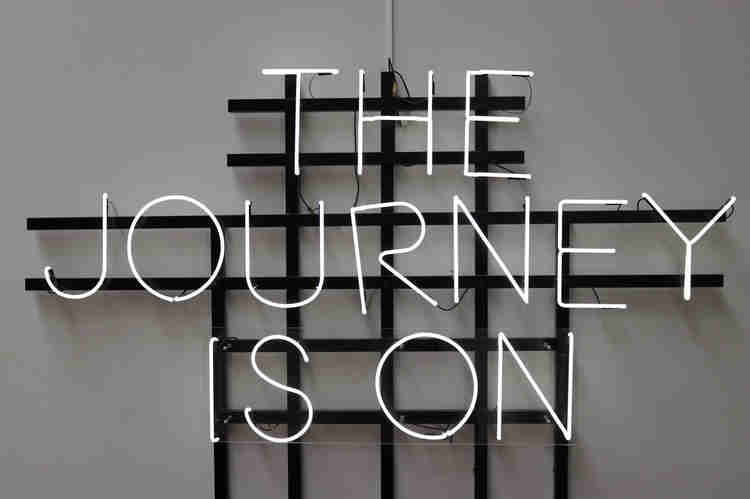As a member of a revenue team, you must be capable of delivering the right message at the right time. When you first learn a sales pitch or how to demonstrate a solution, the positioning is usually very basic - you are being trained to explain the benefits of your solution for typical use cases. As you develop your expertise, you learn to tailor or customize the message in different ways at different times.
“The measure of intelligence is the ability to change.”
―Albert Einstein
As you encounter more and more prospects and client scenarios, you (hopefully) begin to develop more situational fluency, which is an advanced skill that we look to cultivate in revenue teams and when developing future leaders.
An example of failing at Situational Fluency would be demonstrating software to a prospect that is clearly not a match for their use case - for example, showing demo data from apartments to a prospect that only owns commercial real estate. Individual contributors add more value to a team based on the number of potential scenarios that they can serve in. Revenue leaders use this skill when they try to match specific people to specific accounts, verticals or specific deals in specific verticals.
What is Situational Fluency?
The ability to adapt to what the situation requires, in the context of a sales motion or a solution demonstration. To me, situational fluency is just another way to say that you adapt your message to the audience using the correct context. Hopefully your solution has more than one value proposition, and you provide the best problem-solution fit when you can match specific solution capabilities to specific business problems.
"According to Darwin’s Origin of Species, it is not the most intellectual of the species that survives; it is not the strongest that survives; but the species that survives is the one that is able best to adapt and adjust to the changing environment in which it finds itself."
-Leon Megginson
From my experience, here are three ways to immediately improve your situational fluency:
One: Check expectations at the start of any meeting
When any meeting begins, you should always check the expectations of the audience, even if you had a conversation yesterday. A single person that shows up unexpectedly can change the entire context of the meeting. The reality is that the seniority and decision making capability of your biggest critic matters - a lot. I can hear you nodding your head and saying "thanks Captain Obvious! I never would have thought of that!"
So tell me - what did you do to specifically address the main concern of your biggest critic in your last deal cycle? Did you deal with it, or dodge it and pass it to another member or the team? The fact is, even if you can convince the decision maker to override the wishes of everyone else and force the purchase of your solution, it does not end there. If you burn bridges along the way, there is a strong likelihood that the implementation and adoption of your solution will be doomed from the start. Most SaaS companies lose money the first year and depend on multiple year revenue streams to keep growing the snowball of ARR.
Always acknowledge concerns and address them head on by tailoring your message like a "choose your own story" book and explaining how your solution addresses their concern. I am not saying that they will believe you or be convinced, but they will respect the fact that you addressed their concern head on and gave them an answer instead of dodging.
In real life, you rarely make everyone happy, so plan accordingly and understand who you need to persuade if you realize that you have to pick one.

Two: Take a hint
Sometimes you have friends or champions in the audience, sometimes it is a hostile crowd. Facing down the lions and converting skeptics is often more satisfying than preaching to the choir, because it is more of a challenge to do well. Being able to take a hint is being able to read the room - are they reacting well to your message? If not, you need to change your approach. Checking in during the meeting can give you critical clues to how your message is being received.
This is where team selling beats individual salesmen every day of the week ending with a 'y'.
Whenever one member of your revenue team is talking or presenting, the other members of the team need to be watching the expressions of the audience and adding nuggets of insight wherever possible.
For example, if someone has a question that indicates that they are not convinced you can handle their performance requirements, dig in a little - ask why, Is it because of a previous experience with your company in the past? A competitor? Have you ever seen a quarterback that fails to read a defense and calls a running play with too many defenders in front of him? The winning quarterback recognizes the change in the defense and calls an audible to a play that offers a much higher chance of success, the ones that do not, usually show up on defensive highlight videos. Do your best to take the cues provided, uncover the real concern and address it as a team to the best of your ability.

Three: Take them on a journey
This is storytelling in essence, where you start with them in their current situation and you show them how they get to happy by adopting your solution. I love the concept of "Zero to Hero", where one experiences a journey of starting at the bottom (Zero) and growing and ascending to the pinnacle (Hero).
Humans are socialized to learn through stories, and making them the star of the story is an engaging way to help someone understand what you can do to help them. The situational fluency comes into play when you need to explain things in different ways because they might not agree with where you think they are in the story.
I am a big fan of capability maturity models, and I think they empower revenue teams to tell a story of growing together. The basic idea is that you create a model that shows where someone starts without your solution, and what stages they need to go through to become the best possible version of themselves. Not many people or companies are self-aware or humble enough to acknowledge that they are at stage 1, so your empathetic positioning will be key to the response that you elicit.
Use your tools.
When you first start learning to sell something new, you are nervous because you do not want to make a mistake. As you encounter more and more situations and use your tools in different ways, you learn that most solutions can be applied to most problems to varying degrees of success. I am making an assumption that the solution you sell was created in the context of solving a problem and that problem-solution fit was a consideration at some point. For any Matrix fans out there - after a while, you realize there is no spoon. Being able to pivot, adapt, and create bespoke messaging is an advanced sales skill that is worth cultivating because it makes your team more capable during market changes and when you encounter situations that are out of your control.
“You must be shapeless, formless, like water. When you pour water in a cup, it becomes the cup. When you pour water in a bottle, it becomes the bottle. When you pour water in a teapot, it becomes the teapot. Water can drip and it can crash. Become like water my friend.”
― Bruce Lee

David is currently Vice President, Global Sales Engineering at MRI Software and member of the PreSales Leadership Collective.
Connect with David on LinkedIn.
As a member of a revenue team, you must be capable of delivering the right message at the right time. When you first learn a sales pitch or how to demonstrate a solution, the positioning is usually very basic - you are being trained to explain the benefits of your solution for typical use cases. As you develop your expertise, you learn to tailor or customize the message in different ways at different times.
“The measure of intelligence is the ability to change.”
―Albert Einstein
As you encounter more and more prospects and client scenarios, you (hopefully) begin to develop more situational fluency, which is an advanced skill that we look to cultivate in revenue teams and when developing future leaders.
An example of failing at Situational Fluency would be demonstrating software to a prospect that is clearly not a match for their use case - for example, showing demo data from apartments to a prospect that only owns commercial real estate. Individual contributors add more value to a team based on the number of potential scenarios that they can serve in. Revenue leaders use this skill when they try to match specific people to specific accounts, verticals or specific deals in specific verticals.
What is Situational Fluency?
The ability to adapt to what the situation requires, in the context of a sales motion or a solution demonstration. To me, situational fluency is just another way to say that you adapt your message to the audience using the correct context. Hopefully your solution has more than one value proposition, and you provide the best problem-solution fit when you can match specific solution capabilities to specific business problems.
"According to Darwin’s Origin of Species, it is not the most intellectual of the species that survives; it is not the strongest that survives; but the species that survives is the one that is able best to adapt and adjust to the changing environment in which it finds itself."
-Leon Megginson
From my experience, here are three ways to immediately improve your situational fluency:
One: Check expectations at the start of any meeting
When any meeting begins, you should always check the expectations of the audience, even if you had a conversation yesterday. A single person that shows up unexpectedly can change the entire context of the meeting. The reality is that the seniority and decision making capability of your biggest critic matters - a lot. I can hear you nodding your head and saying "thanks Captain Obvious! I never would have thought of that!"
So tell me - what did you do to specifically address the main concern of your biggest critic in your last deal cycle? Did you deal with it, or dodge it and pass it to another member or the team? The fact is, even if you can convince the decision maker to override the wishes of everyone else and force the purchase of your solution, it does not end there. If you burn bridges along the way, there is a strong likelihood that the implementation and adoption of your solution will be doomed from the start. Most SaaS companies lose money the first year and depend on multiple year revenue streams to keep growing the snowball of ARR.
Always acknowledge concerns and address them head on by tailoring your message like a "choose your own story" book and explaining how your solution addresses their concern. I am not saying that they will believe you or be convinced, but they will respect the fact that you addressed their concern head on and gave them an answer instead of dodging.
In real life, you rarely make everyone happy, so plan accordingly and understand who you need to persuade if you realize that you have to pick one.

Two: Take a hint
Sometimes you have friends or champions in the audience, sometimes it is a hostile crowd. Facing down the lions and converting skeptics is often more satisfying than preaching to the choir, because it is more of a challenge to do well. Being able to take a hint is being able to read the room - are they reacting well to your message? If not, you need to change your approach. Checking in during the meeting can give you critical clues to how your message is being received.
This is where team selling beats individual salesmen every day of the week ending with a 'y'.
Whenever one member of your revenue team is talking or presenting, the other members of the team need to be watching the expressions of the audience and adding nuggets of insight wherever possible.
For example, if someone has a question that indicates that they are not convinced you can handle their performance requirements, dig in a little - ask why, Is it because of a previous experience with your company in the past? A competitor? Have you ever seen a quarterback that fails to read a defense and calls a running play with too many defenders in front of him? The winning quarterback recognizes the change in the defense and calls an audible to a play that offers a much higher chance of success, the ones that do not, usually show up on defensive highlight videos. Do your best to take the cues provided, uncover the real concern and address it as a team to the best of your ability.

Three: Take them on a journey
This is storytelling in essence, where you start with them in their current situation and you show them how they get to happy by adopting your solution. I love the concept of "Zero to Hero", where one experiences a journey of starting at the bottom (Zero) and growing and ascending to the pinnacle (Hero).
Humans are socialized to learn through stories, and making them the star of the story is an engaging way to help someone understand what you can do to help them. The situational fluency comes into play when you need to explain things in different ways because they might not agree with where you think they are in the story.
I am a big fan of capability maturity models, and I think they empower revenue teams to tell a story of growing together. The basic idea is that you create a model that shows where someone starts without your solution, and what stages they need to go through to become the best possible version of themselves. Not many people or companies are self-aware or humble enough to acknowledge that they are at stage 1, so your empathetic positioning will be key to the response that you elicit.
Use your tools.
When you first start learning to sell something new, you are nervous because you do not want to make a mistake. As you encounter more and more situations and use your tools in different ways, you learn that most solutions can be applied to most problems to varying degrees of success. I am making an assumption that the solution you sell was created in the context of solving a problem and that problem-solution fit was a consideration at some point. For any Matrix fans out there - after a while, you realize there is no spoon. Being able to pivot, adapt, and create bespoke messaging is an advanced sales skill that is worth cultivating because it makes your team more capable during market changes and when you encounter situations that are out of your control.
“You must be shapeless, formless, like water. When you pour water in a cup, it becomes the cup. When you pour water in a bottle, it becomes the bottle. When you pour water in a teapot, it becomes the teapot. Water can drip and it can crash. Become like water my friend.”
― Bruce Lee

David is currently Vice President, Global Sales Engineering at MRI Software and member of the PreSales Leadership Collective.
Connect with David on LinkedIn.
As a member of a revenue team, you must be capable of delivering the right message at the right time. When you first learn a sales pitch or how to demonstrate a solution, the positioning is usually very basic - you are being trained to explain the benefits of your solution for typical use cases. As you develop your expertise, you learn to tailor or customize the message in different ways at different times.
“The measure of intelligence is the ability to change.”
―Albert Einstein
As you encounter more and more prospects and client scenarios, you (hopefully) begin to develop more situational fluency, which is an advanced skill that we look to cultivate in revenue teams and when developing future leaders.
An example of failing at Situational Fluency would be demonstrating software to a prospect that is clearly not a match for their use case - for example, showing demo data from apartments to a prospect that only owns commercial real estate. Individual contributors add more value to a team based on the number of potential scenarios that they can serve in. Revenue leaders use this skill when they try to match specific people to specific accounts, verticals or specific deals in specific verticals.
What is Situational Fluency?
The ability to adapt to what the situation requires, in the context of a sales motion or a solution demonstration. To me, situational fluency is just another way to say that you adapt your message to the audience using the correct context. Hopefully your solution has more than one value proposition, and you provide the best problem-solution fit when you can match specific solution capabilities to specific business problems.
"According to Darwin’s Origin of Species, it is not the most intellectual of the species that survives; it is not the strongest that survives; but the species that survives is the one that is able best to adapt and adjust to the changing environment in which it finds itself."
-Leon Megginson
From my experience, here are three ways to immediately improve your situational fluency:
One: Check expectations at the start of any meeting
When any meeting begins, you should always check the expectations of the audience, even if you had a conversation yesterday. A single person that shows up unexpectedly can change the entire context of the meeting. The reality is that the seniority and decision making capability of your biggest critic matters - a lot. I can hear you nodding your head and saying "thanks Captain Obvious! I never would have thought of that!"
So tell me - what did you do to specifically address the main concern of your biggest critic in your last deal cycle? Did you deal with it, or dodge it and pass it to another member or the team? The fact is, even if you can convince the decision maker to override the wishes of everyone else and force the purchase of your solution, it does not end there. If you burn bridges along the way, there is a strong likelihood that the implementation and adoption of your solution will be doomed from the start. Most SaaS companies lose money the first year and depend on multiple year revenue streams to keep growing the snowball of ARR.
Always acknowledge concerns and address them head on by tailoring your message like a "choose your own story" book and explaining how your solution addresses their concern. I am not saying that they will believe you or be convinced, but they will respect the fact that you addressed their concern head on and gave them an answer instead of dodging.
In real life, you rarely make everyone happy, so plan accordingly and understand who you need to persuade if you realize that you have to pick one.

Two: Take a hint
Sometimes you have friends or champions in the audience, sometimes it is a hostile crowd. Facing down the lions and converting skeptics is often more satisfying than preaching to the choir, because it is more of a challenge to do well. Being able to take a hint is being able to read the room - are they reacting well to your message? If not, you need to change your approach. Checking in during the meeting can give you critical clues to how your message is being received.
This is where team selling beats individual salesmen every day of the week ending with a 'y'.
Whenever one member of your revenue team is talking or presenting, the other members of the team need to be watching the expressions of the audience and adding nuggets of insight wherever possible.
For example, if someone has a question that indicates that they are not convinced you can handle their performance requirements, dig in a little - ask why, Is it because of a previous experience with your company in the past? A competitor? Have you ever seen a quarterback that fails to read a defense and calls a running play with too many defenders in front of him? The winning quarterback recognizes the change in the defense and calls an audible to a play that offers a much higher chance of success, the ones that do not, usually show up on defensive highlight videos. Do your best to take the cues provided, uncover the real concern and address it as a team to the best of your ability.

Three: Take them on a journey
This is storytelling in essence, where you start with them in their current situation and you show them how they get to happy by adopting your solution. I love the concept of "Zero to Hero", where one experiences a journey of starting at the bottom (Zero) and growing and ascending to the pinnacle (Hero).
Humans are socialized to learn through stories, and making them the star of the story is an engaging way to help someone understand what you can do to help them. The situational fluency comes into play when you need to explain things in different ways because they might not agree with where you think they are in the story.
I am a big fan of capability maturity models, and I think they empower revenue teams to tell a story of growing together. The basic idea is that you create a model that shows where someone starts without your solution, and what stages they need to go through to become the best possible version of themselves. Not many people or companies are self-aware or humble enough to acknowledge that they are at stage 1, so your empathetic positioning will be key to the response that you elicit.
Use your tools.
When you first start learning to sell something new, you are nervous because you do not want to make a mistake. As you encounter more and more situations and use your tools in different ways, you learn that most solutions can be applied to most problems to varying degrees of success. I am making an assumption that the solution you sell was created in the context of solving a problem and that problem-solution fit was a consideration at some point. For any Matrix fans out there - after a while, you realize there is no spoon. Being able to pivot, adapt, and create bespoke messaging is an advanced sales skill that is worth cultivating because it makes your team more capable during market changes and when you encounter situations that are out of your control.
“You must be shapeless, formless, like water. When you pour water in a cup, it becomes the cup. When you pour water in a bottle, it becomes the bottle. When you pour water in a teapot, it becomes the teapot. Water can drip and it can crash. Become like water my friend.”
― Bruce Lee

David is currently Vice President, Global Sales Engineering at MRI Software and member of the PreSales Leadership Collective.
Connect with David on LinkedIn.






.webp)


